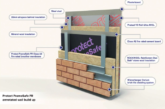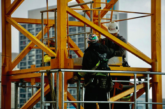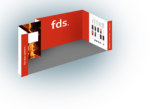
Keith Wells, MD at Quelfire, discusses why compartmentation in buildings relies on effective fire stopping of service apertures.
Fire compartments in buildings are often breached because of mechanical and electrical service penetrations. This can occur while the building is being constructed and gaps around the aperture are not adequately firestopped, or where they are installed incorrectly. It can also occur in existing buildings when apertures for new M&E services are created and then not effectively firestopped. Compromises in this area will mean that the compartment does not achieve the required degree of containment, causing the fire to spread quickly to other areas of the building and seriously restrict the time that occupants have to safely evacuate.
Building Regulations’ Approved Document B requires buildings to be subdivided into a number of discrete compartments using construction materials in order to prevent the passage of fire from one cell to another for a given period of time. These passive fire protection systems effectively compartmentalise a building by creating fire-resistant walls and floors, typically with 30-, 60-, 90- or 120-minute protection. Firestopping products used to maintain the integrity of these compartments must be tested to current standards including BS EN1366-3: 2009 and BS476: Part 20: 1987.
Safe means of escape
An important element of creating an effective passive fire protection system is ensuring buildings are designed with fire-rated compartments. These compartments protect ‘means of escape’ routes from the building, for example, corridors and stairwells. Occupants rely on the integrity of these fire compartments to ensure their safe evacuation. However, over the years, as buildings are renovated or altered, fire compartments can be compromised. Simple changes, such as drilling a hole through a wall for new HVAC or IT services can result in a breach. Even a drill hole the size of a pencil that has not been adequately firestopped can allow rapid spread of smoke in minutes, leading to potentially devastating consequences.
Retaining a safe means of escape for building occupants relies on fire compartmentations being regularly checked. As such, it should be an integral part of any existing fire risk assessment. Building owners and facility managers should verify that whoever is undertaking the fire risk assessment includes a review of fire compartmentation, focussing on whether penetrating services have been suitably firestopped, properly supported, and are in good condition and complete. They should also check for third party certification, including products used and identification of installers. All firestopped penetrations should be labelled and recorded and carried out by a competent person or external fire inspection company.
“Retaining a safe means of escape for building occupants relies on the fire compartmentations being regularly checked and as such should be an integral part of any existing fire risk assessment.”
System approach
A fire compartment that has been incorrectly firestopped will not, in the event of a fire, achieve the required degree of containment. This will allow the fire to spread quickly to other areas of the building and seriously restrict the amount of time that occupants have to safely evacuate via the means of escape.
In response to growing awareness of the importance of effective firestopping, Quelfire has introduced a one-stop-shop system. This is aimed at specialist firestopping contractors, as well as drylining and partitioning installers looking for high quality products that have undergone comprehensive testing. As part of the system approach, the company offers technical back up, which means quicker and more efficient installations, whilst for commercial teams it can present an enhanced value proposition at tender stage.
It is worth seeking out firestopping products with a CE mark, which a growing number now have. Choosing firestopping products with Type X Durability also means they can be exposed to weathering. This is an important consideration on a live construction site because the element that has been firestopped may be left exposed whilst the next phase of construction is completed. The system comprises Fire Batt, Intumescent Acrylic Sealant, Fire Protection Compound, HPE Intumescent Graphite Sealant and Continuous Intuwrap. All the products have undergone rigorous testing as a complete system, so contractors avoid having to source different products from multiple suppliers.
Playing for time
The importance of fire compartments cannot be underestimated — they provide more time for occupants to escape by protecting the integrity of ‘means of escape’ routes such as stairways, whilst delaying the spread of fire to other areas of the building. Multi-storey buildings in particular can result in people trapped on upper floors if fire compartments do not perform as designed. Aside from the obvious danger to people, when a fire compartment does not perform as it should, fire and rescue services are prevented from reaching occupants, compounding the seriousness of the situation.








